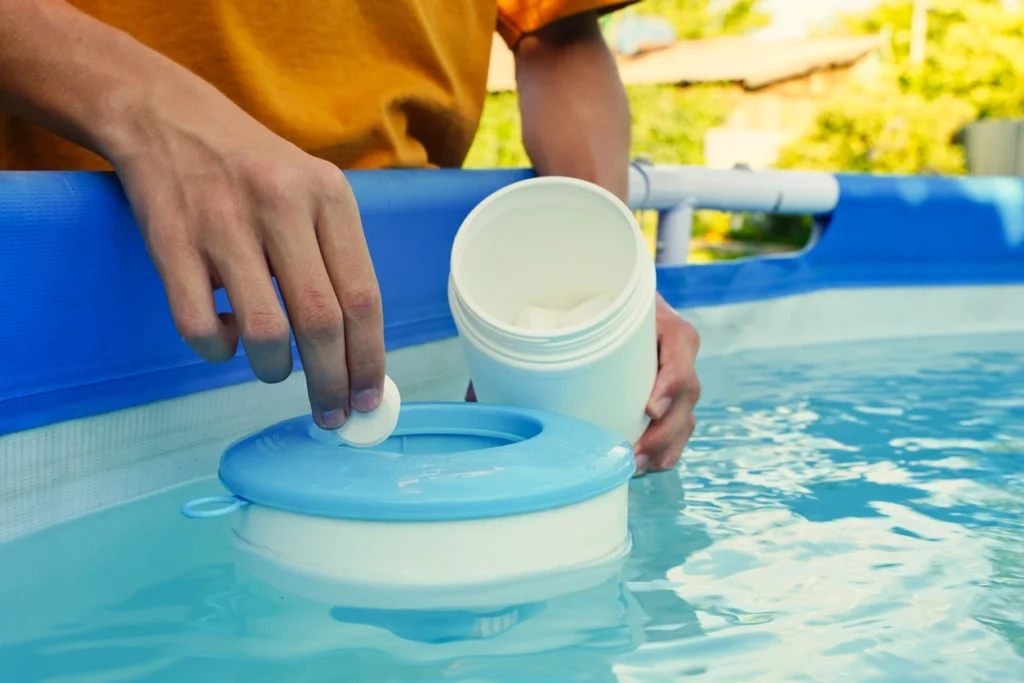A vital pool chemical called Cyanuric Acid (CYA) protects chlorine through stabilization against ultraviolet (UV) radiation from the sun that would otherwise decompose it. When swimming pools lack cyanuric acid (CYA), chlorine control measures break down quickly, which prevents proper sanitation control. Bacteria, algae, and contaminant-killing abilities are weakened when pools lack sufficient CYA. Stabilizers containing CYA exist independently or are incorporated in chlorine products to extend pool water protection periods. Follow and explore how to raise cyanuric acid in the pool.
Why is CYA Important for Pool Water?
Pool chlorine operation depends on maintaining suitable CYA concentrations. When CYA measurement is insufficient, chlorine usage becomes excessive, leading to untreated water and elevated chemical expenses. Efforts to sustain chlorine lock begin when CYA levels exceed recommended proportions. Pools with CYA concentrations between 30 and 50 ppm for outdoor use achieve their optimum stability for chlorine efficiency and extended lifespan. Proper CYA management creates better pool maintenance conditions and delivers a season full of clear water.
Stay Ahead: Test Your Pool Water Weekly
Consistent pool water testing remains essential for achieving water sanitation and equilibrium. Regular testing of CYA and other chemical evaluations at least once weekly allows you to avoid problems with chlorine depletion, algae development, and pH imbalance. Practicing continuous testing, you will learn how to raise cyanuric acid in the pool. It also allows your pool to remain safe and easily preserved in its clear state for extended periods.
Dilution Done? Time to Retest Your Pool Water!
After a deep understanding of how to raise cyanuric acid in the pool and dilute your pool water, always retest to ensure the chemical balance remains optimal. Water replacement can lower cyanuric acid and other key levels, affecting chlorine efficiency. A quick retest helps you adjust chemicals, keeping your pool safe, clear, and ready for swimming.
Use Test Strips for Fast Results
Pool cyanuric acid measurements become simple with quick and easy test strip examinations. All you need to do is see how to raise cyanuric acid in the pool, dip the strip, and let it settle for a few seconds before comparing the results against the provided chart. Regular testing through chemical analysis helps balance your water chemically while protecting your pool from contamination so it maintains its unmistakable quality.
Enhance Testing with a Turbidity Kit
A liquid turbidity test kit is an excellent choice for more detailed and precise cyanuric acid measurements. Unlike test strips, these kits provide a more precise, accurate reading of your pool’s chemical balance. A turbidity test ensures your pool’s water stays at the ideal level, offering safety and clarity.
When Should You Add Cyanuric Acid to Your Pool?
Check your pool’s cyanuric acid content before considering any additions because correct levels matter. When pool water levels fall below optimal marks after rainfall or drainage, you should use cyanuric acid because it helps protect chlorine against UV decay. Regular testing combined with cautious monitoring helps prevent excessive addition so that you achieve precise chemical levels for your pool system.
Buy Cyanuric Acid for Pool Maintenance
Select the right product for your pool size and needs when purchasing cyanuric acid. Cyanuric acid can be found in liquid and granular forms at pool supply stores or online. Opt for a trusted brand that offers clear instructions for safe and practical application, ensuring your pool’s chlorine levels are correctly stabilized.
Balancing Pool Chemicals: Adjust Chlorine, Alkalinity, and pH
To preserve your pool’s water quality, you must confirm that you checked and adjusted chlorine alkalinity and pH levels after adding cyanuric acid. Off-balance chemistry measures from these three levels threaten the pool’s clarity, cleanliness, and swimming comfort. Fast correction is necessary to maintain the swim environment’s health and prolong pool equipment’s lifespan. You must regularly test and adjust your equipment to maintain optimal pool quality.
Perfectly Measure Cyanuric Acid
To determine how to raise cyanuric acid in the pool, consider the following steps:
- Check your pool’s cyanuric acid concentration with a trustworthy testing device.
- Decide the material you need from your pool volume measurement and target measurement parameters.
- The package instructions from the manufacturer guide you in measuring the exact amount of cyanuric acid needed.
- Add the chemical at a steady pace to prevent excessive treatment.

Properly Dissolve Cyanuric Acid in Water
Before introducing it into your pool water, you must dissolve cyanuric acid powder in warm water. This method makes the dissolution process more manageable and prevents the material from turning into clumps. After mixing the solution properly, test it to make sure all molecules have dissolved. Correct pool cyanuric acid addition occurs when you distribute the solution across the pool border, where it combines with water. Commercial pools enhance chlorine efficiency by reaching precise cyanuric acid concentrations through this stratagem.
Adding Cyanuric Acid to Your Pool
This ensures it mixes thoroughly with the water and distributes the acid evenly. Avoid pouring directly into the skimmer or filtration system, which could cause blockages. After adding, allow the pool to circulate for several hours, helping the cyanuric acid dissolve completely and stabilize the water’s chemistry.
Pool Pump Running After Adding Cyanuric Acid
After adding the cyanuric acid, running the pool pump for several hours is crucial for thorough mixing and even distribution. This helps the acid dissolve entirely and stabilizes the pool’s chlorine levels. It’s best to allow the pump to circulate the water continuously to ensure the cyanuric acid integrates properly throughout the pool.
Frequently Asked Questions
What is cyanuric acid (CYA)?
CYA stabilizes chlorine, protecting it from UV rays and maintaining effective sanitization.
What if CYA levels are too high?
Excess CYA reduces chlorine efficiency, leading to sanitation issues.
Can I add CYA to the skimmer?
No, avoid the skimmer to prevent clogs. Pour it around the pool perimeter.
Conclusion
Controlled cyanuric acid levels create essential conditions for adequate chlorine protection, leading to excellent pool water quality. Consistently learning how to raise cyanuric acid in the pool and testing proper mix ratios of cyanuric acid helps you achieve a stable swimming environment with correct chlorine protection. Routine pool maintenance and proper chemical adjustments lengthen the life of your tools while creating a protected and appealing swimming environment for everyone.



